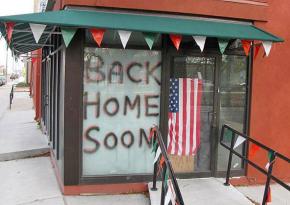Documenting a man-made disaster
Harry Shearer's documentary about Hurricane Katrina and the devastation of New Orleans takes aim at the Army Corps of Engineers. reviews the film.
KATRINA WASN'T a natural disaster--it was man-made. This is the recurring theme of The Big Uneasy, a new documentary about the causes of the catastrophe in New Orleans following the hurricane five years ago.
It wasn't the immediate impact of the storm that caused the flooding which devastated New Orleans, but the fact that the levees failed. And as a new film by humorist and New Orleans resident Harry Shearer argues, the blame lies with the U.S. Army Corps of Engineers, whose responsibility it was to build and maintain the levees and canals.
It could have been prevented--or as University of California-Berkeley Professor Raymond Seed pointed out to the New York Times in 2006, "With the right hurricane protection, the result of Hurricane Katrina would have been very different. We call it wet ankles."
The Big Uneasy makes this case, with extensive detail but also in a very entertaining way. The film illustrates the flooding resulting from specific levee breaks with colorful maps and insets of the actual sites of each levee breach. And it also uses biting satire to help paint a picture of the events around the disaster.

For example, Shearer gives actor John Goodman the job of interviewer in a roundtable discussion among residents who talked about the damage. He asked questions like "Why do people in New Orleans expect the rest of the country to save them?" and "If New Orleans is below sea level, why not just move the city?"
The film focuses on "Team Louisiana," a group of scientists and engineers who conducted their own independent study of why the levees failed. Their conclusions can be found in a series of reports on The Big Uneasy Web site. In summary, they found that, in general, the water didn't come over the top of the levees. Instead, poor construction of the levees allowed the water to go beneath the levees and undermine them, causing the breaks.
Well-known engineering standards weren't applied in the construction of the levees. In one case, a contractor was so appalled by the faulty plans that he sued the Corps of Engineers in an effort to force the Corps to either change the design or let him withdraw from his construction contract. He lost the suit, built the levee and, as he predicted, the levee failed.
A fascinating part of the film is the Corps of Engineers' response to Team Louisiana. When the Corps realized that its report was likely to be critical, the team was prevented from getting close to the levees to perform their studies. In order to continue their work, the scientists and engineers had to get armed escorts from the state. When the team persisted in publicizing their findings, and even joining lawsuits against the Corps, retaliation ensued.
One team member, Professor Ivor van Heerden, was fired from his position at Louisiana State University and had his research centers shut down. He is still suing for reinstatement. A whistleblower who exposed the poor quality of the pumps that were supposed to protect New Orleans was still able to work for the Corps, but she was essentially deprived of real work and forced to resign. And while those who exposed the causes of the disaster were punished, those who caused it still have their jobs and haven't been held accountable.
THE BIG Uneasy also examines the role of environmental destruction in the disaster. Due to previous engineering of the Mississippi River, it no longer dumps sediment into the Gulf of Mexico at the same rate that it once did. This means that the Louisiana coastline has been shrinking for decades, and the coastal wetlands that protect the city from hurricanes are greatly diminished.
An engineering project that contributed to this disaster waiting to happen is the Mississippi River-Gulf Outlet (MRGO), a shipping canal through marshland on the edge of the city. According to the film, MRGO was a boondoggle from the beginning--disastrous environmentally and never economically viable.
Even more frightening is what the film portends for the future. One scene shows a legislative hearing in which an Army Corps officer basically admits that only the areas where the levees actually broke have been repaired to higher standards--but the rest of the levees haven't been upgraded. So in spite of recent press reports of the levees being improved in New Orleans, there's plenty of room to expect future disasters--in New Orleans and elsewhere.
So why does the Army Corps of Engineers act in such a counterproductive way? This film points to problems like its "bad management culture" and the corruption at the heart of the Corps, describing how its projects are often earmarks pushed by congressional representatives in return for campaign contributions from contractors.
But the more fundamental problem is the Corps' failure to prioritize the health and safety of the residents of New Orleans and hundreds of other places across the U.S. that have Corps projects. As the movie points out, the record of the Army Corps is much better for military than for civilian projects. In other words, a re-prioritization of resources to meeting real human needs rather than projection of military power abroad would go a long way toward providing protection from "natural" disasters.
And ultimately, it's capitalism--a society based on the need for profit not fulfilling human needs--that destroys the environment and human welfare in many ways. Katrina is a prime example.
Shearer's expressed attempt to stay away from "politics" in this film does undermine his ability to give a full explanation of the causes of the disaster. But despite this, the film is well worth seeing to gain a more thorough understanding of what led up to the Katrina disaster, and how we can prevent future such events. Some of the scenes of the city and the area are beautiful and even breathtaking. Besides being educational, it's highly entertaining.


